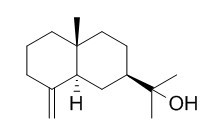Natural Products
beta-Eudesmol
| Catalog No. | CFN99537 |  |
| CAS No. | 473-15-4 | |
| Molecular Weight: | 222.37 | |
| Molecular Formula | C15H26O | |
| DBs | [PubChem]:274950616 [ChEMBL]:10417 [PCIDB]:164 |
Standard InChI:
InChI=1S/C15H26O/c1-11-6-5-8-15(4)9-7-12(10-13(11)15)14(2,3)16/h12-13,16H,1,5-10H2,2-4H3/t12-,13+,15-/m1/s1
Biological Activity
Beta-eudesmol, a sesquiterpenoid alcohol isolated from Atractylodes lancea rhizome, can inhibit angiogenesis, at least in part, through the blockade of the ERK signaling pathway, suggests that it may aid the development of drugs to treat angiogenic diseases.[1]
Beta-eudesmol induces neurite outgrowth in rat pheochromocytoma cells accompanied by an activation of mitogen-activated protein kinase, it may be a promising lead compound for potentiating neuronal function, and the drug may be useful in helping to clarify the mechanisms underlying neuronal differentiation.[2]
Beta-eudesmol has potential anti-angiogenic and anti-tumour activities, it inhibits angiogenesis by suppressing CREB activation in growth factor signalling pathway, is an inhibitor of tumour growth.[3]
Beta-eudesmol induces apoptosis is accompanied by cleavage of caspase-3, caspase-9, and poly (ADP-ribose) polymerase; downregulation of Bcl-2 expression; release of cytochrome c from mitochondria; and decrease in mitochondrial membrane potential (MMP), suggests it induces apoptosis in HL60 cells via the mitochondrial apoptotic pathway, which is controlled through JNK signaling. [4]
Product
References
[1] Tsuneki H, Ma E L, Kobayashi S, et al. Eur J Pharmacol, 2005, 512(2-3):105-15.
[2] Obara Y, Aoki T, Kusano M, et al. J Pharmacol Exp Ther, 2002, 301(3):803-11.
[3] Tsuneki H. J Asian Nat Prod Res, 2008, 10(1-2):159-167.
[4] Li, Yanchun, Li, et al. Phytother Res, 2012, 27(3):338-43.
[5] Chen Y M, Chou G X, Wang Z T. China journal of Chinese materia medica, 2007, 32(21):2265-7.
Product Use Citation





